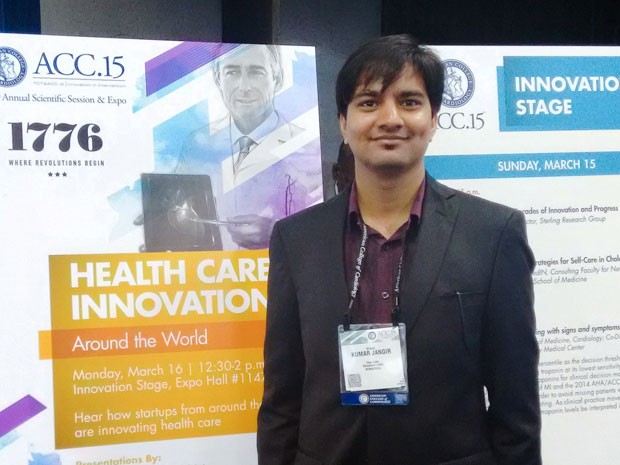
IEEE Member Nitesh Kumar Jangir grew up dreaming of becoming a doctor. But when he couldn’t get into the medical school of his choice, he decided to pursue an undergraduate degree in electronics engineering instead, a popular career path in India.
That decision altered his life and potentially those of many others in his country. Late last year, Jangir cofounded Coeo Labs, in Bangalore, India. (Coeo is Latin for “to unite.”) The startup designs low-cost medical devices for emergency and critical care. One of these devices prevents pneumonia in patients on ventilators by stopping nasal passage secretions from getting into their lungs. Another device in the works will help newborns breathe when they experience respiratory distress.
The 25-year-old innovator has patents pending in India as well as through the International Patent System on these and three other devices. His company nabbed this year’s Tata Social Enterprise Challenge, a competition to find Indian ventures likely to have the greatest social impact. Jangir also won numerous awards, including the All IEEE-R10 Young Engineers’ Humanitarian Challenge in 2011, which recognizes people under the age of 35 who are developing a technology that addresses a community need. He was also named one of India’s top 50 innovators jointly by the Indian government’s Department of Science and Technology and Lockheed Martin, the aerospace company.
STARTING UP
Jangir’s founding of Coeo Labs resulted from his 2014 stint as a fellow at India’s first program to accelerate the development of innovative medical devices, InnAccel, in Bangalore. He was the only engineer on an interdisciplinary team that included a product designer, three physicians, and a business school graduate. The team spent eight weeks at the city’s St. Johns Medical College Hospital to identify problems in emergency room procedures that technology could solve.
Jangir and the product designer started Coeo to address some of these problems. Founded with money from private capital and government grants, Coeo operates in InnAccel’s incubator offices. Jangir does the technical “heavy lifting,” designing the products’ electronics and control systems.
One product is a portable suction machine connected to a thin endotracheal tube inserted through the nose or mouth into the air passage of a patient on a ventilator. Patients cannot effectively clear their mouths and nasal passage secretions, which can get contaminated with germs and travel to the lungs. The machine senses and removes the secretions before they reach the lungs. An external machine-learning interface controls the suction. Computer simulations and tests on medical airway training mannequins show that the technique works well, Jangir says. Coeo plans to start clinical trials next year. The technology was selected as a regional winner in the health challenge category by the global incubator and investment fund 1776.
Jangir’s other device is a simple, manually operated pump to help newborns and infants breathe when they’re under respiratory distress. At hospitals, such babies are placed on continuous positive airway pressure machines, which maintain constant air pressure through tubes inserted into each nostril to keep the lungs from collapsing. Rural clinics don’t have such machines.
Coeo’s mechanical tool converts the variable pressure applied by a person using a pressure-generating device such as a manual resuscitator, which includes a foot pump, to supply the air. Once a nurse in a rural clinic inserts breathing tubes into an infant’s nose, a family member could pump the breathing device until the baby reaches a hospital, Jangir says. The device will sell for 12,000 Indian rupees (less than US $200), which should be affordable for rural clinics, he adds.
A DOCTOR AT HEART
Jangir was born in the small village of Shivnagar in the Indian state of Rajasthan, about 1,200 kilometers north of Bangalore. He earned his bachelor’s degree in 2011 in electronics engineering at the Rajeev Gandhi Technical University in Bhopal, India. But he had maintained his interest in medicine.
After a two-year stint as an engineer at Electro Systems Associates, he was accepted as an intern in the Stanford-India Biodesign program, a collaboration among Stanford, the Indian Institute of Technology Delhi, and the All India Institute of Medical Sciences. There, he developed a device called Thorashield, which can help physicians remove extra fluid that builds up in lung walls due to diseases such as tuberculosis. Licensed to medical supply company Mecmaan Healthcare, in New Delhi, the device was introduced to market in March.
Jangir still hopes to get his title of doctor by eventually earning a Ph.D. “But it won’t happen any time soon,” he says. For now, he is busy trying to save lives as an engineer.






